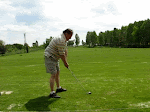We asked the following questions in the previous article: what should we do to let the sweetspot guide our swings through the MOI axis automatically ? And how to make our forearms and wrists be parts of our clubs ? In order to find the answers we need to take into account a little of biophysics. Prof. Theodore P. Jorgensen, in his excellent book titled "The Physics od Golf", explains to golfers how to use angular acceleration and torques to their benefit on base of the experiments illustrated below (the stick symbolizes golfer's lead arm):
We can see that if the lead shoulder pulls the arm parallelly there will be no lead arm rotation; if arm is angled to the vector of pulling force, the rotation will happen.
The difference between Prof. Jorgensen's examples and our studies is since we would like to have both humera as parts of the body while both forearms be a part of the club. It should be pointed out that forearm rotation is much easier achievable than the rotation of the whole arm which is very important in view of a subtle difference between club's MOI axis and shaft. Such a scenario is possible only when arms are not extended or hyperextended. It is easy to see this making a simple excercise: extend fully your arm and rotate it -- the whole arm (humerus and forearm) rotates; when it is not extended (only a little not extended is enough) -- only the forearm rotates (we wrote about this phenomenon in the first series of our articles in 2010, see: 'The Arms'). Let us see now our diagramme based on the Prof. Jorgensen's examples below:
It is to be pointed out that the sense of rotation will be always enhanced by the fact that the club rotated around its MOI axis and not around the shaft. Automation is full and the only one condition is not to allow the arms (especially the left one) extend fully at address and during the first part of the backswing. The lead arm will straighten unintentionally later on with the help of lack of centripetal force and, finally, with the help of gravity.
Nevertheless, there is one more important problem, namely the wrist joint that somehow links the forearm to the club. If wrists are like the chain between two nunchaku sticks it would be perfect. Alas, it is not despite the fact that wrist joints are very mobile ones. The point is to allow its full mobility come into force.
The best solution for having both allowing the automation of forearm rotation as well as full mobility of the wrists I could ever find is a firm but loose grip. You might remember both articles referring to building automatically a very firm grip (i.e. 'The Tale of a Left-Handed Knight and a Lady with Fan' and 'Melting Two Hands into One. Rear Hand Joins the Puzzle' from the year 2014) -- they are very valid always. Tightening the grip by fingers' action has a very big negative effect on both cases. However, it is antisubconscious to let the grip be very loose as our subconscious mind does not want to let the club go out of our hands, therfore, we need to use a smart trick here. Please take a look on the following GIF (taken from one of my favourite Western movies titled "The Fastest Gun Alive"):
Put a special attention to how the Vinnie Harold character (played by the great actor Broderick Crawford) treat his guns before a forthcoming duel. He pronates both forearms to the inside using his thumbs in order to minimalize the friction between his guns and holsters and avoiding any potential blocking). Surprisingly, this action is in a great accordance with the process of forming the Bio-K grip (merging a strong lead and a weak rear hand position); it sort of tightens the grip several times before loosing the tightness. Watch closely again in a slow motion:
The above method works for us perfectly, but it can be one of quite a few ones. The most important goal is to ensure maximal loosenes of wrists while maintaining stability of gripping the club lightly.
If we are able to fulfill this goal everything become automatic -- forearms act involuntarily following the club rotating around its MOI axis and, in consequence, helping vividly in creating a repeatable shallow arc of the sweetspot that we want to achieve.
And here is a small video reassuming the whole subject:




















